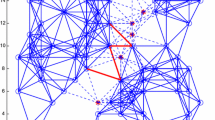Abstract
In this paper we consider the problem ofk-partitioning the nodes of a graph with capacity restrictions on the sum of the node weights in each subset of the partition, and the objective of minimizing the sum of the costs of the edges between the subsets of the partition. Based on a study of valid inequalities, we present a variety of separation heuristics for cycle, cycle with ears, knapsack tree and path-block cycle inequalities among others. The separation heuristics, plus primal heuristics, have been implemented in a branch-and-cut routine using a formulation including variables for the edges with nonzero costs and node partition variables. Results are presented for three classes of problems: equipartitioning problems arising in finite element methods and partitioning problems associated with electronic circuit layout and compiler design. © 1998 The Mathematical Programming Society, Inc. Published by Elsevier Science B.V.
Similar content being viewed by others
Explore related subjects
Discover the latest articles and news from researchers in related subjects, suggested using machine learning.References
D. Applegate, R.E. Bixby, V. Chvátal, W. Cook, Finding cuts in the TSP, DIMACS Technical Report, 1994, pp. 95–05.
F. Barahona, A. Casari, On the magnetisation of the ground states in two dimensional Ising spin glasses, Computer Physics Communications 49 (1988) 417–421.
F. Barahona, M. Grötschel, M. Jünger, G. Reinelt, An application of combinatorial optimization to statistical physics and circuit layout design, Operations Research 36 (1988) 493–513.
F. Barahona, A. Mahjoub, On the cut polytope, Mathematical Programming 36 (1986) 157–173.
N. Boissin, Optimisation des Fonctions Quadratiques en Variables Bivalentes, Thèse de Doctorat, Conservatoire National des Arts et Métiers, Paris, 1994.
L. Brunetta, M. Conforti, G. Rinaldi, A branch-and-cut algorithm for the resolution of the equicut problem, Working Paper no. 361, IASI-CNR, Rome, 1993.
S. Chopra, M.R. Rao, On the multiway cut polyhedron, Networks 21 (1991) 51–89.
C.E. Ferreira, A. Martin, C.C. de Souza, R. Weismantel, L.A. Wolsey, The node capacitated graph partitioning problems: formulations and valid inequalities, Mathematical Programming 74 (1996) 247–267.
C.E. Ferreira, A. Martin, R. Weismantel, A cutting plane based algorithm for the multiple knapsack problem, SIAM J. on Optimization 6 (1996) 858–877.
C.M. Fiduccia, R.M. Mattheyses, A linear time heuristic for improving network partitionings, in: Proceedings of the 19th Design Automation Conference, Las Vegas, 1982, pp. 175–181.
M. Grötschel, Y. Wakbayashi, A cutting plane algorithm for a clustering problem, Mathematical Programming Series B 45 (1989) 59–96.
S. Holm, M.M. Sorensen, The optimal graph partitioning problem, OR Spektrum 15 (1993) 1–8.
D.S. Johnson, C.R. Aragon, L.A. McGeoch, C. Schevon, Optimization by simulated annealing: an experimental evaluation: Part I, Graph partitioning, Operations Research 37 (1989) 865–892.
E. Johnson, A. Mehrotra, G.L. Nemhauser, Min-cut clustering, Mathematical Programming 62 (1993) 133–152.
M. Jünger, A. Martin, G. Reinelt, R. Weismantel, Quadratic 0/1 optimization and a decomposition approach for the placement of electronic circuits, Mathematical Programming 63 (1994) 257–279.
W. Kernighan, S. Lin, An efficient heuristic procedure for partitioning graphs, Bell Systems Technical Journal 49 (2) (1970) 291–307.
T. Lengauer, Combinatorial Algorithms for Integrated Circuit Layout, Wiley, New York, 1990.
M.W. Padberg, G. Rinaldi, A branch and cut algorithm for the resolution of large-scale symmetric traveling salesman problems, SIAM Review 33 (1991) 60–100.
H.L.G. Pina, An algorithm for frontwidth reduction, International Journal on Numerical Methods in Engineering 17 (1981) 1539–1546.
C.C. de Souza, The graph equipartition problem: optimal solutions, extensions and applications, Doctoral Thesis, Faculté des Sciences Appliquées, Université Catholique de Louvain, Louvain-la-Neuve, Belgium, 1993.
C.C. de Souza, R. Keunings, L.A. Wolsey, O. Zone, A new approach to minimising the frontwidth in finite element calculations, Computer Methods in Applied Mechanics and Engineering 111 (1994) 323–334.
F. Vanderbeck, Decomposition and column generation for integer programs, Doctoral Thesis, Faculté des Sciences Appliquées, Université Catholique de Louvain, Louvain-la-Neuve, Belgium, 1994.
R. Weismantel, Plazieren von Zellen: Theorie and Lösung eines quadratischen 0–1 Optimierungs-problem, Dissertation, Technische Universität, Berlin, 1992.
Author information
Authors and Affiliations
Additional information
Corresponding author.
Rights and permissions
About this article
Cite this article
Ferreira, C.E., Martin, A., de Souza, C.C. et al. The node capacitated graph partitioning problem: A computational study. Mathematical Programming 81, 229–256 (1998). https://doi.org/10.1007/BF01581107
Received:
Revised:
Issue Date:
DOI: https://doi.org/10.1007/BF01581107




